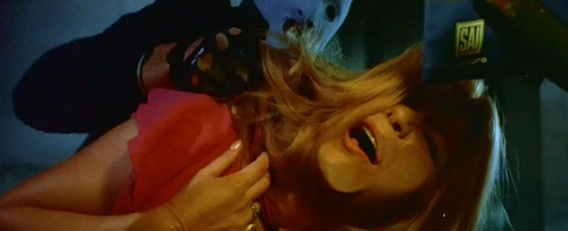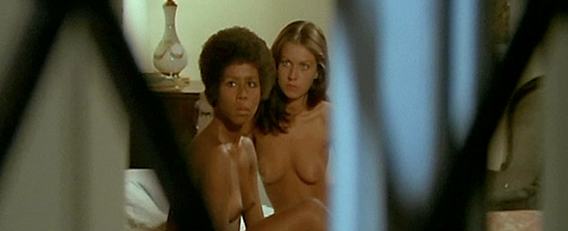
Whilst the giallo has often bordered on sleazy and misogynistic, usually the filmmakers have been wise to tread carefully when flirting with sex and violence, often avoiding featuring both in any given shot. Mario Bava’s Reazione a catena (aka Twitch of the Death Nerve) had disgusted audiences and Dario Argento’s ‘Animal Trilogy‘ had boasted impressive murders, but these were usually displayed with a level of subtlety and style. But this was not the case with I corpi presentano tracce di violenza carnale, Sergio Martino’s shocking 1973 thriller that is more known to horror fans as Torso, a gruesome and erotic tale of a deranged killer stalking a group of young girls. A forerunner to the slasher film, Torso spends its first thirty minutes displaying as much flesh as possible, in between such outrageous sequences as a semi-naked girl being strangled, her breasts fondled and then her chest sliced open in full view of the glaring camera. Yet, somewhere amongst its debauchery and sadism, Torso stands as an impressive example of how ‘more is more,’ with Martino dispensing with intricate storylines or characterisation in favour bloodsoaked T&A.
Sergio Martino was born on July 19 1938 in Rome, the grandson of famed director Gennaro Righelli, who had created the first Italian ‘talkie’ with 1930’s La canzone dell’amore. Following in the footsteps of his older brother, Luciano, Sergio first entered the film industry as an actor in the 1959 comedy I ragazzi dei parioli (Boys of the Parioli), before progressing to second assistant directing four years later with Il demonio (The Demon), directed by Brunello Rondi, who would later be nominated for an Oscar for his co-writing credit on Federico Fellini’s 1963 drama 8½. After collaborating with his brother on the thriller Le spie uccidono a Beirut (The Spy Killers), he made his directorial in 1969’s Mille peccati… nessuna virtù (Mondo Sex), a pseudo documentary which unsuccessfully attempted to pass its softcore contents off as educational. The early seventies would become his most prolific period, with a succession of inventive giallo features including Lo strano vizio della Signora Wardh (The Strange Vice of Mrs. Wardh), La coda dello scorpione (The Scorpion’s Tale) and Il tuo vizio è una stanza chiusa e solo io ne ho la chiave (Your Vice Is a Locked Room and Only I Have the Key), all released between 1971 and 1972. The following year would see him shock the genre to its foundations when he unleashed Torso upon an unsuspecting world.
Long before it was given its more accessible moniker, Torso went into production under the name I corpi presentano tracce di violenza carnale, translated as The Bodies Present Traces of Rape (or, literally, The Bodies Show Traces of Carnal Violence), a title which gives the viewer some kind of indication of what to expect. This project would mark his sixth collaboration with writer Ernesto Gastaldi, whose first teaming had resulted in Martino’s first feature, Arizona si scatenò… e li fece fuori tutti (If You Gotta Shoot Someone… Bang! Bang!). Having gained acclaim from giallo fans for his tense and stylish thrillers, Martino was determined to take the genre a step further by producing a movie which his contemporaries had merely hinted at. Lucio Fulci’s earlier attempts at producing shocking murder mysteries – Una lucertola con la pelle di donna (A Lizard in a Woman’s Skin) and Non si sevizia un paperino (Don’t Torture a Duckling) – had caused minor controversy but Martino intended on pushing the formula to the extreme.
Any film that boasts a tagline such as ‘Where Whores Meet Saws’ immediately raises certain expectations. Torso was not designed as a thoughtful social commentary or a multilayered character study but instead as a confrontational and disturbing tale of sex and murder. This was hardly a new concept, American filmmaker Herschell Gordon Lewis had produced a slew of low budget splatter flicks throughout the sixties including Blood Feast, Two Thousand Maniacs! and The Gruesome Twosome, before his lucky streak came to an end with The Gore Gore Girls in 1972. Prosthetics had advanced leaps and bounds in the intervening ten years since Lewis had first soaked the screen with Karo syrup and as the technology advanced, so did the genre’s need to shock and disgust its audience. Whilst Bava and Argento had been schooled in the Hitchcock style of interweaving subplots and the power of suggestion, Martino would instead employ Lewis’ method of ‘show everything.’ But what Torso lacked in restraint it more than made up for in excess.
Even from the opening credits, which play over images of a threesome, Martino made his intentions clear. The director fills the screen with as much naked flesh as possible, from skinny dippers to bare breasted victims, in what is perhaps his most graphic picture. Torso centres on an American student studying in Rome (many gialli featured foreign protagonists), who retreats with a group of friends to a country villa when a masked killer stalks her college campus. When another victim is found with fibre from the scarf that had been used to strangle her on the body, the police warn the students that the killer could be wearing the garment and to be cautious around anyone fitting the description, whilst one-by-one the story points fingers at each of the male characters as the possible villain. But whilst the first sixty minutes flirt with a sleazy alternative to the giallo, the third act features an intense cat-and-mouse chase that was later heavily referenced in the likes of Halloween, Friday the 13th and almost every slasher that followed.
Torso, much like Martino’s other giallo, boasted a selection of talented names amongst its ranks. The producer was the late Carlo Ponti, husband of screen legend Sophia Loren and the man behind such successes as Doctor Zhivago and Zabriskie Point, as well as cult favourites like Un posto ideale per uccidere (Oasis of Fear). Cinematographer Maurizio De Angelis had not only worked with the director on Tutti i colori del buio (All the Colors of the Dark) and Your Vice Is a Locked Room and Only I Have the Key but had also as a camera operator on Nude… si muore (Naked You Die) and 10.000 dollari per un massacro (Ten Thousand Dollars for a Massacre). The cast also featured a few recognisable faces, especially among fans of Italian horror. After first making a name for himself in Bava’s La maschera del demonio (Black Sunday) in 1960, the English actor appeared in several Hammer movies, including She and One Million Years B.C. Roberto Bisacco had co-starred alongside Olivia Hussey – who would later find minor fame with her role in Black Christmas – in Franco Zeffirelli’s 1968 adaptation of Romeo and Juliet, in which he portrayed Count Paris, the hero’s rival. Hollywood born Tina Aumont had taken her career to Europe in the sixties which had led to various roles in French and Italian features.
Perhaps Torso‘s biggest star was its heroine, Suzy Kendall. Born Freida Harrison in England on New Year’s Day 1944, Kendall appeared briefly in the James Bond blockbuster Thunderball before landing a major role in Dario Argento’s debut L’uccello dalle piume di cristallo (The Bird With the Crystal Plumage), in which she co-starred as the love interest of the star, Tony Musante. The tense finale of Torso sees Kendall’s character, Jane, chased by the masked killer around the villa, only for her to watch in terror as he butchers her friend with a hacksaw. Proving to be a more than capable leading lady, Kendall’s turn would inspire the many ‘final girls’ which would follow throughout the eighties, with Halloween‘s Laurie and Friday the 13th‘s Alice clearly owing a debt to her. Another star of the movie is the breathtaking locations, with De Angelis’ cinematography capturing the beauty of the Italian countryside. Principal photography took place in early 1972 at Monte Gelato Falls (where Don’t Torture a Duckling had also filmed) as well as Rome, Perugia and Tagliacozzo.
To keep an air of suspense, none of the cast were informed who the real killer was until it was time to shoot the big reveal, leading to speculation among the actors. For its American release, scheduled for November 1973, distributor Joseph Brenner had acquired several Italian pictures and had decided that the picture should be renamed Torso to help make it accessible to the type of audiences that had flocked to see Twitch of the Death Nerve and The Bird With the Crystal Plumage. This alternative title also helped to cash in on the recent wave of Italian thrillers who had boasted sleazy titles, such as Andrea Bianchi’s Nude per l’assassino (Strip Nude for Your Killer). Deciding to remove some of the more offensive moments, the opening scene with the orgy was edited out, as was much of the gore. The film was often screened as a double bill with Tobe Hooper’s American horror The Texas Chainsaw Massacre, despite being far removed from Hooper’s more suggestive film. These early edits also resulted in the omitted footage having no English audio track, so the recent DVD releases of the movie have these extra scenes in Italian, despite the rest of the film being dubbed. For thirty-five years, Torso has divided audiences due to its explicit nature. It certainly is not for all tastes, but those willing to give it a try may not be disappointed.


One Response to SPAGHETTI SLASHERS – Torso